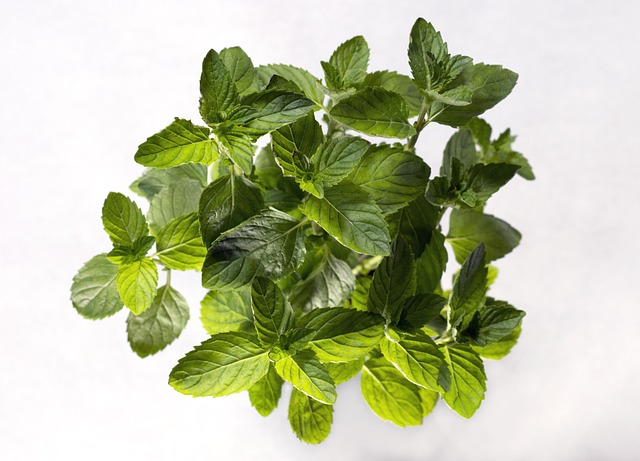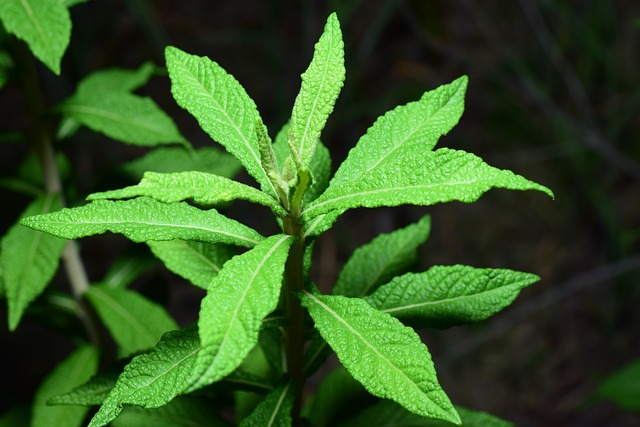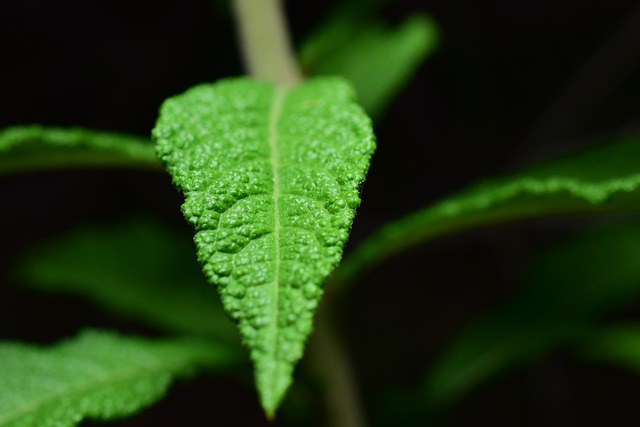White spots on spearmint leaves can be a common issue for gardeners and plant enthusiasts. These spots can be caused by a variety of factors, including fungal infections, pest infestations, and environmental stressors.
It is important to identify the cause of the white spots in order to effectively treat and prevent them from reoccurring.
Identifying white spots on spearmint leaves can be done by visually inspecting the leaves for any discoloration or abnormal growths. White spots may appear as powdery or fuzzy growths on the leaves, or as circular patches with a white or yellowish hue.
It is important to note that not all white spots on spearmint leaves are harmful, as some may simply be a natural occurrence or a result of environmental factors such as humidity or temperature changes.
Common causes of white spots on spearmint leaves include fungal infections such as powdery mildew or white rust, as well as pest infestations from insects such as spider mites or aphids.
Environmental stressors such as overwatering or lack of sunlight can also contribute to the development of white spots on spearmint leaves. It is important to properly identify the cause of the white spots in order to effectively treat and prevent them from reoccurring.
Key Takeaways
- White spots on spearmint leaves can be caused by a variety of factors, including fungal infections, pest infestations, and environmental stressors.
- Proper identification of the cause of white spots is important in order to effectively treat and prevent them from reoccurring.
- Prevention methods such as proper watering and sunlight exposure can help minimize the occurrence of white spots on spearmint leaves.
More posts on this category:
Identifying White Spots on Spearmint Leaves

Spearmint is a popular herb that is widely used in cooking, teas, and medicines. However, like any other plant, spearmint is susceptible to various diseases and pests that can cause significant damage to the plant.
One of the most common problems that spearmint growers face is the appearance of white spots on the leaves. These white spots can be caused by several factors, including fungal infections, pests, and viruses.
1. Powdery Mildew
Powdery mildew is a fungal disease that affects many plants, including spearmint. It appears as a white or gray powdery coating on the leaves, stems, and flowers of the plant. The spots are usually circular and can merge to form large patches.
Powdery mildew can weaken the plant and make it more susceptible to other diseases and pests. It is essential to identify and treat powdery mildew early to prevent it from spreading.
2. Spider Mites and Thrips
Spider mites and thrips are two common pests that can cause white spots on spearmint leaves. These tiny insects feed on the sap of the plant, causing white or silver patches on the leaves.
Spider mites are more common in hot and dry weather, while thrips prefer cooler temperatures. Both pests can cause significant damage to the plant if left untreated.
3. Fungal Infections
Fungal infections are a common cause of white spots on spearmint leaves. These infections can be caused by various biotrophic fungi, including white mint rust and Sclerotinia Rot.
White mint rust appears as small white pustules on the leaves, while Sclerotinia Rot causes white mold on the stems and leaves. Fungal infections can weaken the plant and make it more susceptible to other diseases and pests.
4. Mosaic Virus
Mosaic virus is a viral disease that affects many plants, including spearmint. It appears as irregular white or yellow spots on the leaves, which can merge to form large patches. The virus can cause stunted growth, deformed leaves, and reduced yield. Mosaic virus can be transmitted by insects, contaminated soil, and infected plant material.
White Spots on Spearmint Leaves – 4 Common Problems
White spots on spearmint leaves can be caused by a variety of factors, both biotic and abiotic. Here are some of the most common causes of white spots on spearmint leaves:
1. Fungal Infections
Fungal infections are a common cause of white spots on spearmint leaves. Powdery mildew is a fungal disease that can cause white or gray spots on the leaves. It is caused by a fungus that thrives in warm, humid conditions.
Another fungal disease that can cause white spots on spearmint leaves is white rust. This disease is caused by a fungus that attacks the leaves, stems, and flowers of the plant.
2. Pest Infestations

Pest infestations can also cause white spots on spearmint leaves. Spider mites, mealybugs, whiteflies, and aphids are all common pests that can infest spearmint plants. These pests can cause damage to the leaves, which can result in white spots. Spider mites, in particular, are known for causing white spots on leaves.
3. Too Much Water
Overwatering can also cause white spots on spearmint leaves. When plants are overwatered, the roots can become waterlogged, which can lead to a buildup of salts in the soil. This can cause white spots to appear on the leaves. It is important to water spearmint plants only when the soil is dry to the touch.
4. Nutrient Deficiencies
Nutrient deficiencies can also cause white spots on spearmint leaves. If the plant is not receiving enough nutrients, it may develop white spots on the leaves. This can be remedied by fertilizing the plant with a balanced fertilizer.
Effect of White Spots on Mint Leaves
White spots on spearmint leaves can significantly affect the plant’s health, appearance, and flavor. These spots can be caused by various biotic and abiotic factors, including fungal diseases, pest infestation, nutrient deficiency, and incorrect watering.
When white spots appear on the leaves, it can reduce the plant’s ability to photosynthesize, leading to stunted growth and reduced yield. The spots can also spread to other parts of the plant, including the stems and veins, causing further damage.
In addition to affecting the plant’s health, white spots can also impact the appearance of the mint leaves. The spots can make the leaves look unsightly and unappetizing, which can be a problem for those who use fresh mint leaves in their cooking or for tea.
Moreover, white spots on mint leaves can also affect the flavor and aroma of the plant. The spots can alter the chemical composition of the leaves, leading to a bitter taste and an unpleasant smell. This can be a problem for those who use mint leaves for their health benefits and flavor.
Preventing and Treating White Spots
White spots on spearmint leaves are caused by various reasons, including fungal diseases, pest infestations, and nutrient deficiencies. However, there are preventive measures and treatments that can help keep your spearmint plants healthy and free from white spots.
Preventive Measures
Prevention is better than cure, and this applies to spearmint plants too. Here are some preventive measures that can help keep your plants healthy:
- Water your plants regularly, but avoid overwatering, as this can lead to fungal growth.
- Use a water hose to wash off any dust or debris that may accumulate on the leaves. This will help prevent fungal growth and pest infestations.
- Use neem oil or insecticides to prevent and control pest infestations. Neem oil is a natural insecticide that is safe for plants and humans.
- Rotate your crops to prevent the buildup of pests and diseases in the soil.
- Use resistant varieties of spearmint that are less susceptible to white spots.
Treatment Options

If you notice white spots on your spearmint leaves, here are some treatment options that can help:
- Use a baking soda recipe to treat fungal diseases. Mix one tablespoon of baking soda and one teaspoon of liquid soap in one gallon of water and spray the solution on the affected leaves. Repeat every week until the white spots disappear.
- Use neem oil or insecticides to control pest infestations. Follow the instructions on the product label for best results.
- Check for nutrient deficiencies and adjust the soil pH and nutrient levels accordingly. Spearmint plants require well-draining soil with a pH between 6.0 and 7.0.
In addition to these treatments, you can also try some home remedies, such as using a mixture of garlic and water or a solution of milk and water to treat fungal diseases. However, these remedies may not be as effective as commercial products.
Identifying and Treating Fungal Infections
Mint plants are susceptible to fungal infections, which can cause white spots on the leaves. Fungal infections can be caused by various pathogens, including Sclerotinia rot and powdery mildew. These infections can be identified by the appearance of white spots on the leaves, which can spread and cause damage to the plant if not treated promptly.
Sclerotinia rot is a fungal infection that can affect mint plants. It is caused by the fungus Sclerotinia sclerotiorum, which produces white, cottony growth on the leaves. The fungus can also cause the plant to wilt and die.
To treat Sclerotinia rot, infected leaves should be removed and destroyed. The plant can also be treated with a fungicide to prevent further spreading of the infection.
Powdery mildew is another fungal infection that can affect mint plants. It is caused by the fungus Erysiphe cichoracearum, which produces a white, powdery growth on the leaves.
The fungus can cause the leaves to curl and turn yellow, and can also stunt the growth of the plant. To treat powdery mildew, infected leaves should be removed and destroyed. The plant can also be treated with a fungicide to prevent further spreading of the infection.
Viral infections can also cause white spots on mint leaves. These infections are caused by viruses that can be transmitted by insects or through infected plant material. Viral infections can cause a variety of symptoms, including white spots on the leaves, stunted growth, and distorted leaves.
Unfortunately, there is no cure for viral infections, and infected plants should be removed and destroyed to prevent further spreading of the virus.
Spearmint and Peppermint: A Comparison
Spearmint and peppermint are two of the most popular mint varieties, and they are often used interchangeably in teas, drinks, and cooking. However, they have distinct differences that make them unique.
1. Physical Characteristics
Spearmint (Mentha spicata) has a bright green color, and its leaves are more elongated and pointed than peppermint (Mentha x piperita), which has a darker green color and rounded leaves. Peppermint also has purple stems and flowers, while spearmint has pink or white flowers.
2. Flavor and Aroma

Peppermint has a stronger, more intense flavor and aroma due to its higher menthol content. Spearmint, on the other hand, has a sweeter, milder flavor with a hint of minty freshness. Peppermint is often used in desserts and candies, while spearmint is used in savory dishes and drinks.
3. Uses
Peppermint is commonly used to help with digestive issues, headaches, and congestion due to its high menthol content. Spearmint is used to freshen breath, aid digestion, and reduce stress. Both mints can be used in teas, drinks, and cooking, but peppermint is more commonly used in desserts and candies.
4. Planting and Care
Both spearmint and peppermint are easy to grow and care for, and they are often grown in gardens or containers. They prefer well-draining soil and partial to full sun, and they can be propagated by cuttings or division. However, peppermint can be more invasive than spearmint, so it may need to be contained.
5. Infected Plants
Mint plants, including spearmint and peppermint, are susceptible to various fungal diseases, such as powdery mildew and rust. These diseases can cause white spots on the leaves, which can affect the plant’s growth and health.
To prevent these diseases, it is important to water the plants at the base, avoid overcrowding, and remove infected leaves and plants promptly.
Frequently Asked Questions
How to get rid of white spots on my mint leaves?
To get rid of white spots on mint leaves, it is important to first identify the underlying cause. Common causes of white spots on mint leaves include fungal infections, pest infestations, viral infections, nutrient deficiencies, and incorrect watering.
Once the cause has been identified, appropriate treatment can be applied. This may include pruning affected leaves, applying fungicides or insecticides, adjusting watering and fertilization schedules, or repotting the plant.
How to treat fungus on mint plant?
To treat fungus on mint plants, it is important to first identify the type of fungus present. Common types of fungus that affect mint plants include powdery mildew and downy mildew.
Treatment may involve pruning affected leaves, applying fungicides, improving air circulation around the plant, and adjusting watering and fertilization schedules. It is important to follow the instructions on the fungicide label and wear appropriate protective gear when applying chemicals.
What is the white mold on mint leaves?
The white mold on mint leaves is likely to be powdery mildew. Powdery mildew is a fungal infection that appears as a white or gray powder on the leaves and stems of affected plants.
It can be caused by a variety of factors, including high humidity, poor air circulation, and crowded plant conditions. Treatment may involve pruning affected leaves, applying fungicides, and adjusting environmental conditions to prevent the spread of the infection.
What are the spots on mint plant leaves?
The spots on mint plant leaves can be caused by a variety of factors, including fungal infections, pest infestations, viral infections, nutrient deficiencies, and incorrect watering. It is important to identify the underlying cause in order to determine the appropriate treatment.
Common treatments may include pruning affected leaves, applying fungicides or insecticides, adjusting watering and fertilization schedules, or repotting the plant.
How do you treat white spots on herbs?
The treatment for white spots on herbs will depend on the underlying cause. Common causes of white spots on herbs include fungal infections, pest infestations, viral infections, nutrient deficiencies, and incorrect watering.
Treatment may involve pruning affected leaves, applying fungicides or insecticides, adjusting watering and fertilization schedules, or repotting the plant.
How do you get rid of fungus on mint leaves?
To get rid of fungus on mint leaves, it is important to first identify the type of fungus present. Common types of fungus that affect mint plants include powdery mildew and downy mildew.
Treatment may involve pruning affected leaves, applying fungicides, improving air circulation around the plant, and adjusting watering and fertilization schedules. It is important to follow the instructions on the fungicide label and wear appropriate protective gear when applying chemicals.

Hey, I’m Lisa and I’ve been an avid gardener for over 30 years. I love writing, talking and living in the garden! Feel free to connect with me on my socials below


